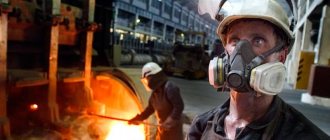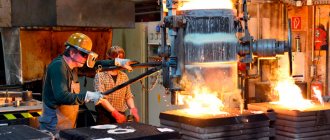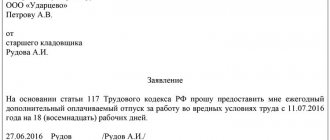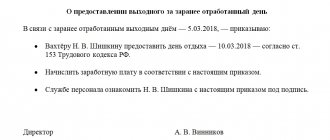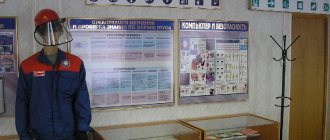For some employees, mandatory medical examinations may be established upon hiring, during their working career, as well as extraordinary ones, depending on their state of health. Such workers, in particular, include workers who work in jobs with harmful or dangerous working conditions. They undergo mandatory medical examinations when applying for a job and periodic medical examinations to determine their health status. This is necessary to understand whether the employee can perform his work duties, as well as to timely diagnose the occurrence of occupational diseases.
Harmful factor: why establish harmfulness
Harmfulness is a certain impact of certain working conditions that negatively affect the human body, its physical condition and health.
There are 4 degrees of harmfulness:
- Conditions that have a minimal impact on health and are to a low degree associated with the acquisition of occupational diseases or injuries. If some negative changes occur in the body, they are subject to real restoration.
- Conditions under which the human body is subject to permanent changes. Chronic occupational diseases of an irreversible nature appear, constantly developing and worsening the state of health.
- Conditions associated with periodic disability due to acquired occupational diseases.
- Conditions as a result of which the disease becomes severe. The employee loses his ability to work for a long period of time.
In this regard, it is important for a person to know in advance what conditions he will work under. That is why there was a need for a list of hazardous professions with particularly hazardous working conditions (especially grades 3 and 4).
Harmful working conditions list of professions 2021
GOVERNMENT OF THE RUSSIAN FEDERATION dated February 25, 2000 N 163 On approval of the list of heavy work and work with harmful or dangerous working conditions, during which the employment of persons under eighteen years of age is prohibited (as amended by
Decrees of the Government of the Russian Federation dated June 20, 2001 N 473, dated June 20, 2021 N 479) In accordance with Article 10 of the Federal Law “On the Fundamentals of Occupational Safety and Health in the Russian Federation” (Collection of Legislation of the Russian Federation, 1999, N 29, Art. Order of the Ministry of Health and Social Development of Russia dated 04/12/2021 N 302n (ed.
How to determine harmfulness
According to the law, conditions are considered harmful if they result in a deterioration in a person’s health, a weakened immune system, a deterioration in their ability to reproduce, or the appearance of occupational diseases.
Issues regarding the recognition of certain professions as hazardous are dealt with by the Labor Inspectorate. To recognize a particular profession as hazardous, a special assessment of work is carried out according to various criteria. Based on the sum of these factors, a decision is made about the harmfulness of the profession.
If a profession is found to be harmful to health, the person will be given special benefits.
Today, there are 2 lists in healthcare with professions and areas of activity that have a negative impact on health. Their difference from each other lies in the degree of influence of harmful factors on the worker’s health, but the same professions can be found in both lists of industries with hazardous working conditions.
List of professions with hazardous working conditions according to the Labor Code of the Russian Federation in 2021
Representatives of dangerous and hazardous professions are provided with a number of benefits that must be strictly observed by the employer. This includes the following points:
Of course, these are rather vague formulations, and many citizens can certainly classify their profession as harmful and dangerous. To avoid labor disputes and misunderstandings, there is a list of professions established at the state level, which takes into account all potentially dangerous areas of work.
List 1
This list includes professions with particularly hazardous working conditions:
- employees working in mountainous areas;
- persons who work underground most of the time;
- workers with ore and similar minerals;
- people from the metallurgical industry;
- workers related to coal processing and mining;
- people from the metallurgical sector;
- persons involved in working with mercury substances, chemical production, as well as ammunition and other explosives;
- citizens engaged in the extraction and processing of gas, oil, shale and coal;
- workers employed at power plants;
- employees of metallurgical enterprises;
- persons engaged in the production of electronic equipment, glass, building materials;
- workers extracting peat;
- food and drug industry employees;
- citizens engaged in the production of paints, printing, and the film copying industry;
- workers in communications, healthcare, transport, social professions;
- persons working in the field of nuclear energy;
- workers associated with radioactive elements, as well as the production of synthetic fibers;
- servicing the agro-industrial complex in the field of disposal of animal corpses.
Workers from the list of these hazardous professions experience severe harm to their health.
Long-term employment in these areas can lead to complete disability and even death. Representatives of hazardous occupations from the first list have the right to early retirement (10 years earlier than others).
To use this benefit, several conditions must be met:
- men must work for at least 20 years, and half of this period they must work in a position in a particularly dangerous profession;
- women must work 15 years, half of which must be worked in hazardous conditions.
If these requirements are met, the employee can apply for early retirement.
List of professions with hazardous working conditions
Today, there is a Government Decree according to which people working in hazardous conditions have the right to receive certain benefits . The first list was approved more than 60 years ago and applies to those people who began their working career under the Soviet Union, the second list of hazardous professions is intended for people working in modern Russia.
- High dust content in the atmosphere. In particular, the work of the lungs is hampered when dust settles in them. Moreover, the higher the content of harmful substances in the dust, the more destruction such breathing brings to a person.
- Poor quality lighting. In conditions of insufficient or inappropriate lighting, the human psyche is most sensitive and susceptible to disorder, as well as the mood and physical condition of a person.
- Loud noises.
- Harmful radiation.
- Working with harmful objects such as viruses and microorganisms.
- Working with harmful chemicals.
- Vibrations, dirt.
- Increased humidity levels.
- High or low temperature.
- Difficulty, duration and intensity of work.
List 2
This list contains professions that do not pose a great danger, but with harmful working conditions at work, which in the future may negatively affect the worker’s body:
- people working in mountainous areas;
- people engaged in the processing of ore and other similar minerals;
- metallurgy workers;
- workers associated with the production of refractories, hardware, coke, as well as metallurgical production and explosives;
- employees associated with mercury converters;
- persons extracting mineral resources;
- people involved in metalworking;
- citizens engaged in the repair of electrical equipment, as well as work at power plants;
- employees in the production of building materials, glass, electronics, and pulp products;
- people extracting peat;
- employees of light industry, as well as healthcare and other social facilities;
- workers involved in the production of medicines; workers employed in the field of communications, transport, construction, paint production, as well as printing and film-copying production, synthetic fiber;
- persons serving the agro-industrial complex in the field of disposal of dead animals; people associated with radioactive substances;
- nuclear industry employees.
Have you already noticed that the second list contains many professions from the first list? The fact is that the field of activity, as well as the simple location of such workers, in many ways in itself negatively affects the body (for example, working underground). But people from the second list will experience slightly less negative influence.
People in this category can also count on early retirement. With the required 55 (for women) and 60 (for men), workers in “harmful” sectors have the right to leave 5 years earlier. But it is important to comply with the following conditions:
- the total work experience of men must be at least 25 years, half of which must have been worked in hazardous conditions;
- The total work experience of women must be at least 20 years, half of which must have been worked in hazardous conditions.
You can exercise your right to early retirement immediately at the moment this right becomes available. It will be enough to submit the following documents to the relevant authority (Pension Fund):
- passport,
- statement,
- SNISL,
- documents confirming work experience (including professions from any list above).
And although it’s too early for you to think about early retirement, you should know in advance whether your profession is on the list of health hazards. This can greatly influence future choices. Well, while you are wondering whether the game is worth the candle, someone should study for you. Let there always be a reliable assistant nearby in the form of student services, who will reduce harm to a minimum.
This video is unavailable
Those who work in hazardous industries will be able to retire at the age of 50. Plus, the employer must pay professional pension contributions for such people for at least five years. Since 2021, about 7 thousand companies began paying pensions for employees, and 400 thousand Kazakhstanis became participants in this system.
— Already in 2021, the first opportunity appears, when persons employed in hazardous working conditions have reached the age of 50, have the opportunity, due to the total accumulation of their pension contributions of 10 percent and those 5 percent whose professional contributions are paid by the employer, to buy a pension annuity from insurance companies. Today, on average, it takes just over 8 million in savings to purchase a retirement annuity.
We recommend reading: How long can children under 14 go for walks?
Harmful and dangerous working conditions list of professions 2021
- High dust content in the atmosphere. In particular, the work of the lungs is hampered when dust settles in them. Moreover, the higher the content of harmful substances in the dust, the more destruction such breathing brings to a person.
- Poor quality lighting. In conditions of insufficient or inappropriate lighting, the human psyche is most sensitive and susceptible to disorder, as well as the mood and physical condition of a person.
- Loud noises.
- Harmful radiation.
- Working with harmful objects such as viruses and microorganisms.
- Working with harmful chemicals.
- Vibrations, dirt.
- Increased humidity levels.
- High or low temperature.
- Difficulty, duration and intensity of work.
We recommend reading: How much does it cost to reissue a Pensioners Transport Card?
This meant and means that people work in enterprises and production where there are high health risks. The negativity that a person receives from such work was smoothed out, at least with free milk (we are talking about the Soviet Union, where milk was given out free of charge, according to the established norm, depending on the impact of the aggressive environment on a person).
What should we understand by this?
As harmful production factors (HPF), it is necessary to understand the content of the conditions and elements of labor that are associated with increased risk, high physical or psychological stress on the employee’s health indicators. Increases in the permissible level are determined on a case-by-case basis. Information characterizing other types of activities is taken as a basis.
Exceeding the established HPF standards recorded at the enterprise indicates the presence of harmful conditions that are present when carrying out the workload. A significant excess of such indicators gives grounds to talk about the presence of dangerous conditions.
The list of VPF presented at the legislative level is quite extensive. It may have significant differences based on professional characteristics. HMF can be classified into 4 large groups:
- physical, i.e. those characterized by factors of noise, vibration, radiation, low levels of illumination, high humidity, exposure to low or high temperature conditions;
- chemical, i.e.
Harmful and Dangerous Working Conditions List of Professions 2021
— the BPP press service quotes Konstantin Yarynich. The deputy added that the list excludes such positions and professions of healthcare workers as radiologists, x-ray technicians, employees of healthcare institutions who directly work with radioactive substances, workers of pathological morgues, specialists directly serving patients in tuberculosis, infectious diseases, psychiatric, and oncology institutions. “As a practicing doctor with many years of experience, I know well that, for example, employees of the radionuclide diagnostics department and the x-ray department spend about 80% of their working time in conditions of ionizing radiation, which negatively affects their health.
“In the developed draft government resolution, from lists No. 1 and No. 2, without proper justification, virtually the entire list of professions and positions in healthcare, employment in which, due to difficult working conditions, today guarantees the right to retire before the generally established age,” is excluded without proper justification.



